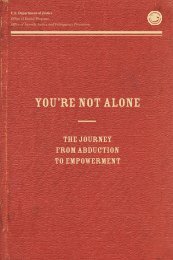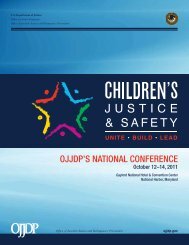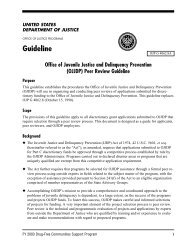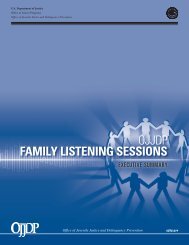Forming a Multidisciplinary Team To Investigate Child Abuse
Forming a Multidisciplinary Team To Investigate Child Abuse
Forming a Multidisciplinary Team To Investigate Child Abuse
Create successful ePaper yourself
Turn your PDF publications into a flip-book with our unique Google optimized e-Paper software.
U.S. Department of Justice<br />
Office of Justice Programs<br />
Office of Juvenile Justice and Delinquency Prevention<br />
DEPARTMENT<br />
BJA<br />
OFF ICE<br />
N I J<br />
OF<br />
OF<br />
OJJ DP<br />
JUSTICE<br />
JUSTICE<br />
OVC<br />
BJS<br />
PROGRAMS<br />
<strong>Forming</strong> a<br />
<strong>Multidisciplinary</strong><br />
<strong>Team</strong> <strong>To</strong><br />
<strong>Investigate</strong><br />
<strong>Child</strong> <strong>Abuse</strong><br />
Portable Guides to<br />
Investigating <strong>Child</strong> <strong>Abuse</strong>
Foreword<br />
When a child is the victim of abuse or neglect, it is the<br />
responsibility of each member of the child protective service<br />
and criminal justice communities to provide a timely and<br />
appropriate response.<br />
<strong>To</strong> promote the coordination and teamwork needed to ensure<br />
such a response—and to minimize additional trauma to<br />
children—a growing number of jurisdictions have established<br />
multidisciplinary teams (MDT’s) comprising professionals<br />
from law enforcement, child protective services, prosecution,<br />
medicine, counseling, and related fields.<br />
<strong>Forming</strong> a <strong>Multidisciplinary</strong> <strong>Team</strong> <strong>To</strong> <strong>Investigate</strong> <strong>Child</strong> <strong>Abuse</strong><br />
delineates the benefits that an MDT offers and provides<br />
advice on forming and operating an effective team. Diverse<br />
MDT models are described and keys to making the team a<br />
success—confidentiality policies, conflict resolution practices,<br />
and periodic review—are discussed.<br />
It is my hope that this guide will be a valuable resource to<br />
current and potential MDT members and that it will enhance<br />
coordination among these professionals and improve the<br />
timeliness and effectiveness of their investigations. Only<br />
through such improvements can we fulfill our duty to protect<br />
children and bring those who abuse and neglect them to<br />
justice.<br />
Shay Bilchik<br />
Administrator<br />
Office of Juvenile Justice and<br />
Delinquency Prevention<br />
November 1998<br />
Second Printing March 2000<br />
NCJ 170020
Two months before her seventh birthday in<br />
1995, Elisa Izquierdo was killed. Over a<br />
period of months, she had been physically<br />
and emotionally abused,<br />
repeatedly violated with<br />
a toothbrush and a<br />
hairbrush, and finally<br />
beaten to death by her<br />
mother. Elisa’s mother<br />
told police that before<br />
she smashed Elisa’s head<br />
against a cement wall, she<br />
made Elisa eat her own feces and used her head to mop<br />
the floor. The police told reporters that there was no<br />
part of the 6-year-old’s body that had not been cut or<br />
bruised. Thirty marks initially thought to be cigarette<br />
burns turned out to be the imprints of a stone in<br />
someone’s ring.<br />
An investigation after her death revealed that Elisa had<br />
been the subject of at least eight reports of abuse and<br />
that several government agencies had investigated the<br />
reports. Nonetheless, Elisa Izquierdo was left with her<br />
abuser and eventual killer.<br />
1
Unfortunately, this failure to respond to reports of child abuse<br />
in a timely and appropriate manner has happened many times—<br />
and is continuing to happen—in probably every State in the<br />
country, and almost always for the same reason: As the<br />
investigation into Elisa’s death revealed, there had been an<br />
appalling lack of communication and coordination among the<br />
agencies investigating reports of possible abuse. The first<br />
recommendation of the New York State commission mandated<br />
to find out how to prevent another such tragedy was to adopt<br />
legislation to authorize child protection agencies to provide<br />
complete information to all members of a county’s designated<br />
multidisciplinary team (MDT) or child advocacy center.<br />
An MDT is a group of professionals who work together in a<br />
coordinated and collaborative manner to ensure an effective<br />
response to reports of child abuse and neglect. Members of<br />
the team represent the government agencies and private<br />
practitioners responsible for investigating crimes against<br />
children and protecting and treating children in a particular<br />
community. An MDT may focus on investigations; policy<br />
issues; treatment of victims, their families, and perpetrators;<br />
or a combination of these functions. This Portable Guide deals<br />
with the investigative function of MDT’s.<br />
The MDT approach promotes wellcoordinated<br />
child abuse investigations<br />
✔<br />
that benefit from the input and attention<br />
of many different parties—especially<br />
law enforcement, prosecution, and<br />
child protective services—to ensure a<br />
successful conclusion to the investigation<br />
and to minimize additional trauma to the child victim.<br />
Key to the formation of successful investigative MDT’s are:<br />
✹ Committed members who have the support of their agencies for<br />
the multidisciplinary approach.<br />
✹ An initial meeting during which each member’s role and previous<br />
experience in investigating child abuse and neglect are<br />
respectfully heard.<br />
✹ The development of a mission statement that clearly sets forth the<br />
purpose of the team, the scope of its activities, and its guiding<br />
principles.<br />
2
✹ The subsequent creation of a team protocol that specifies the<br />
types of cases that will be investigated, the responsibilities of<br />
the members, and the procedures for conducting investigations.<br />
Key to the successful operation of an MDT are:<br />
✹ Confidentiality policies that accord with legislative mandates,<br />
agency policies, professional practices, and the best interests of<br />
the abused children.<br />
✹ Conflict resolution practices that ensure core issues are aired and<br />
resolved satisfactorily based on mutual respect and recognition<br />
that child abuse investigations are complex, demanding, and<br />
frustrating but that they are also important, meaningful, and<br />
rewarding.<br />
✹ Periodic self-analysis and outside evaluation of how the team is<br />
working so that it continues to achieve the purposes for which it<br />
was formed.<br />
Need for a <strong>Team</strong> Approach<br />
Over the past two decades, the number of reports of child<br />
abuse and neglect has greatly increased, straining resources<br />
to investigate allegations effectively. A number of cases have<br />
been the subject of intense media coverage. Although helping<br />
to raise public awareness of the problem, this coverage has<br />
also led to a backlash that includes charges of government<br />
witch-hunts on the one hand and accusations of government<br />
inaction on the other. Whatever the perception, there is<br />
significant outside pressure on professionals to act promptly,<br />
yet professionally and correctly, when faced with a report of<br />
child abuse or neglect.<br />
Research related to child abuse has increased dramatically<br />
in the same period. More information than ever before—in<br />
the areas of specialized child development issues, victim and<br />
offender dynamics, diagnostic imaging, traumatic memory,<br />
linguistics, forensic pathology, and others—is available to help<br />
practitioners discover the truth of a report. Moreover, to meet<br />
the competing demands of child protection, due process, and<br />
family preservation, laws have been repeatedly changed and<br />
refined in the areas of evidence, procedure, and definitions<br />
related to abuse and neglect. The existence of such abundant<br />
yet diverse and technical data and legal requirements places<br />
significant demands upon professionals who investigate and<br />
prosecute these increasingly difficult cases.<br />
3
No single profession or State agency has the ability to respond<br />
adequately to any allegation of child maltreatment. Indeed,<br />
several professions and State agencies are mandated to report<br />
or investigate suspicions of child abuse and neglect or to provide<br />
services to abused children or the perpetrators of abuse.<br />
It is now well accepted that the best response to the challenge<br />
of child abuse and neglect investigations is the formation of an<br />
MDT. In fact, formation of such teams is authorized, and often<br />
required, in more than three-quarters of the States and at the<br />
Federal level. Hospitals have been using MDT’s in a variety<br />
of ways for nearly 40 years.<br />
The MDT approach often extends beyond joint investigations<br />
and interagency coordination into team decisionmaking. <strong>Team</strong><br />
investigations require the full participation and collaboration<br />
of team members, who share their knowledge, skills, and<br />
abilities. <strong>Team</strong> members remain responsible for fulfilling their<br />
own professional roles while learning to take others’ roles and<br />
responsibilities into consideration.<br />
An effective response to reports of child abuse and neglect is<br />
an investigation that is timely and objective and that causes<br />
the least possible trauma to children and families. Effective<br />
teamwork can prevent further abuse to children and can bring<br />
those who harm children to justice. Some of the recognized<br />
benefits of a proficient MDT include:<br />
✹ Less “system inflicted” trauma to children and families.<br />
✹ Better agency decisions, including more accurate investigations<br />
and more appropriate interventions.<br />
✹ More efficient use of limited agency resources.<br />
✹ Better trained, more capable professionals.<br />
✹ More respect in the community and less burnout among child<br />
abuse professionals.<br />
These benefits can translate into safer communities.<br />
Types of <strong>Multidisciplinary</strong> <strong>Team</strong>s<br />
MDT’s can take several forms and may involve different<br />
locales:<br />
✹ Some are part of a children’s advocacy center (CAC), which<br />
provides a child-friendly facility where forensic interviews, and<br />
4
sometimes medical examinations and treatment, are conducted.<br />
The CAC may serve as the site for team meetings and trainings<br />
and may also house representatives of member agencies. CAC’s<br />
also often do community outreach and public education. There<br />
are more than 400 established and developing centers nationwide.<br />
✹ Other MDT’s may not provide the more comprehensive services<br />
of a CAC but may establish a particular place for conducting<br />
interviews. Such teams may be based in hospitals, prosecutors’<br />
offices, or within child protective services agencies. The San<br />
Diego <strong>Child</strong>ren’s Hospital and Health Center has specially<br />
trained interviewers who use an area designed specifically for<br />
interviewing children.<br />
✹ Hundreds of effective teams are not part of a CAC and do not have<br />
special interview facilities. These teams use available resources<br />
to accomplish, in different but effective ways, many of the same<br />
purposes—reducing trauma to victims and families, improving the<br />
accuracy of information obtained during the investigation, and<br />
easing the strain on member agencies and investigators.<br />
No single type of team is best. The model you choose will<br />
depend on the resources available and the way various<br />
agencies function in your community.<br />
<strong>Forming</strong> a <strong>Team</strong><br />
Creating an MDT involves several steps: identifying and<br />
recruiting members, developing a mission statement and<br />
protocol, establishing and maintaining good working<br />
relationships among team members, and evaluating the<br />
team’s performance.<br />
Some agencies have worked together very well in an informal<br />
though systematic manner for a period of time, usually because<br />
the individuals representing them work well together. The<br />
creation of a formal MDT—by institutionalizing the team and<br />
documenting its functions and procedures on paper—ensures<br />
continuity of existing coordination and collaboration beyond<br />
the tenure of specific individuals.<br />
<strong>Team</strong> Participants<br />
In many States, the membership of MDT’s is defined by statute.<br />
Generally, laws authorizing or requiring the formation of<br />
investigative MDT’s specify that law enforcement, child<br />
protection or family services, and prosecution participate. Even<br />
if your State does not require such membership, these three<br />
5
disciplines and the medical professions should be considered<br />
the core of any investigative MDT. Depending on the resources<br />
available in your community, other potential members include<br />
mental health professionals, victim services coordinators,<br />
court-appointed special advocates, and educators. In federally<br />
recognized Indian Country and government reservations,<br />
such as a military base, the Federal Bureau of Investigation<br />
has investigative jurisdiction and must be included in any MDT.<br />
Everyone on the team must be committed to the concept<br />
that a coordinated and collaborative process is required for<br />
successful investigation of reported instances of child abuse.<br />
That commitment may not be fully developed when the team<br />
is first formed, but there must be at least an agreement to<br />
implement the team philosophy.<br />
<strong>To</strong> be viable, an MDT must have support of the leadership of<br />
its members’ organizations and agencies. <strong>To</strong> gain support<br />
for forming an MDT, seek out professionals working in other<br />
MDT’s in your area or in your profession and communicate<br />
their experience to others in your organization. Share the<br />
current literature on the team approach, which overwhelmingly<br />
supports the MDT concept. For instance, one study has<br />
revealed that in a jurisdiction where an MDT created a close<br />
working relationship between law enforcement and child<br />
protective services, three out of four cases were referred for<br />
criminal prosecution, and nearly 95 percent of those cases<br />
resulted in convictions. 1 Those proportions are much higher<br />
than in jurisdictions without MDT’s. Other research has<br />
suggested that MDT’s, by reducing the number of investigatory<br />
interviews a child must endure, reduce “system intervention<br />
trauma” as well. 2<br />
Initial Meeting<br />
An initial meeting of potential team members is critical to<br />
laying the foundation for success. Any interested person<br />
can call, convene, schedule, or coordinate the first meeting.<br />
Participants in the initial meeting should discuss their<br />
reasons for attending the meeting and the advantages<br />
1<br />
Tjaden PG, Anhalt J, The Impact of Joint Law Enforcement—<strong>Child</strong> Protective<br />
Services Investigations in <strong>Child</strong> Maltreatment Cases, Denver, CO: Center for<br />
Policy Research, September 1994.<br />
2<br />
Henry J, System intervention trauma to child sexual abuse victims<br />
following disclosure, Journal of Interpersonal Violence 12(4), August 1997.<br />
6
and disadvantages of implementing the team method of<br />
investigating suspected harm to children.<br />
The need for investigations will most likely be universally<br />
expressed, sometimes in terms reflecting the frustrations<br />
commonly felt by professionals handling these cases. It is<br />
important for all participants to hear what other people are<br />
saying and to be heard by others. Members will express<br />
opinions reflecting their professional training. Their opinions<br />
may be heated because they feel defensive about criticism of<br />
their agencies or angry about the ways their agencies have<br />
failed to protect children from abuse. Statements like the<br />
following may set a tone of angry or bitter criticism:<br />
✹ “<strong>To</strong>o many cases, not enough resources.”<br />
✹ “Someone dropped the ball.”<br />
✹ “The facts are too complex.”<br />
✹ “The victim’s behavior is unpredictable and misunderstood.”<br />
✹ “No one understands the restrictions I face.”<br />
✹ “You want to put people in jail; I need to put families back<br />
together.”<br />
It is vital that these comments be understood as the first step<br />
in acknowledging the failings of current investigative practice.<br />
These are the types of obstacles that face every new MDT.<br />
Because participants generally concur about the importance of<br />
the work and need for a team, they should be able to maintain<br />
an overall positive attitude. The use of a seasoned facilitator,<br />
who will not be a team member, can provide the structure<br />
necessary to create a climate of mutual respect and attention.<br />
All potential team members should be consulted in the choice<br />
of a facilitator, to avoid the appearance of too much control<br />
by any one member.<br />
At this initial meeting, participants should also discuss<br />
additional team membership—agencies or individuals vital<br />
to the proper functioning of the team. Finally, participants<br />
should begin to work on a mission statement.<br />
Writing a Mission Statement<br />
A mission statement is a general declaration of purpose—<br />
the scope of your team’s activities, its goals, and the guiding<br />
principles for achieving those goals. It should concisely<br />
7
describe the reason the team was formed and the purpose it<br />
will serve. It should be easily understood by team members<br />
and by the broader community. Your team should consider the<br />
following questions in developing its mission statement:<br />
✹ Why was the team formed?<br />
✹ What are the common values held by each team member?<br />
✹ Who is on the team?<br />
✹ What jurisdiction or community will the team serve?<br />
✹ How does the team want to be perceived?<br />
✹ What types of cases will the team investigate?<br />
✹ What other functions will the team perform?<br />
✹ What challenges does the team face?<br />
✹ How will the team meet those challenges?<br />
Do not attempt to incorporate the answers to all these<br />
questions. The mission statement is supposed to be short<br />
(five or fewer sentences) and specific enough to provide an<br />
adequate measure of success. It should be simple, direct,<br />
and inspirational. The preamble to the Constitution, for<br />
example, sets forth its mission statement in these few words:<br />
“. . . in order to form a more perfect union, establish justice,<br />
insure domestic tranquility, provide for the common defense,<br />
promote the general welfare, and secure the blessings of<br />
liberty to ourselves and our posterity. . . .” This simple<br />
mission statement has guided a very large and complex<br />
organization for more than 200 years.<br />
<strong>To</strong> be relevant, the mission statement must also be tied to<br />
the everyday workings of the team’s member agencies.<br />
Buzzwords, jargon, and platitudes will not provide a clear<br />
vision for team members or the community. The mission<br />
statement for your team will be the reference point for its<br />
protocol, which will be the team’s next project.<br />
Writing a Protocol<br />
A properly written protocol is essential if a team is to function<br />
well. For an MDT, it is the written understanding of how<br />
investigations and other functions will be pursued by team<br />
members and the roles and responsibilities of member agencies.<br />
8
The agencies and individuals signing the document signify their<br />
mutual commitment to the team and the team’s mission<br />
statement.<br />
The team’s protocol is a practical, working document. Where<br />
the mission statement is conceptual, the protocol is concrete.<br />
The protocol serves as a reference when questions or disputes<br />
arise within the team. When there is a written agreement<br />
specifying investigative roles and responsibilities, conflict<br />
is reduced because there is a shared understanding of<br />
investigatory practice. Moreover, when investigations are<br />
conducted in a relatively predictable and consistent manner,<br />
the stress associated with uncertainty is minimized, resulting<br />
in less conflict. Diminished interagency conflict means more<br />
energy and attention are spent on the investigation itself,<br />
contributing to swifter and more precise resolutions. That<br />
in turn can alleviate trauma to children and their families.<br />
Because many State statutes now mandate team formation,<br />
it is important that you consult applicable State law when<br />
drafting your team’s protocol. Many teams have also found it<br />
helpful to review protocols developed in similar communities.<br />
(Samples of protocols are available from the National<br />
Network of <strong>Child</strong>ren’s Advocacy Centers, the four regional<br />
CAC’s, and the National Center for Prosecution of <strong>Child</strong><br />
<strong>Abuse</strong>. See pages 21–23.) However, every community should<br />
work out an agreement that suits its own resources and needs.<br />
What works in Chicago or San Diego may not work in smaller<br />
or more rural communities.<br />
Regardless of the size or location of your community, a number<br />
of issues must be addressed in every protocol. As you address<br />
these issues, keep in mind the wide range of incidents in child<br />
abuse reports—for example, a dirty house, a 2-year-old<br />
wandering down a highway, sexual abuse, physical abuse, or<br />
suspected child homicide. Balance the need for structure and<br />
certainty with the necessity for creativity and flexibility. If you<br />
agree in writing to follow a specific procedure, there may be<br />
legal or procedural repercussions when that procedure is not<br />
followed, no matter how compelling the reason for departing<br />
from the protocol. Some teams have used a particularly complex<br />
or difficult case as a point of departure when formulating a<br />
protocol.<br />
9
Figure 1 lists questions that will help in creating a protocol.<br />
Note that the questions address the “who, what, when, where,<br />
and how” of investigations and of team function. In addition<br />
to addressing these questions, some teams have found it<br />
useful to specify the criteria for arresting suspects, removing<br />
children from their homes, and filing charges.<br />
The benefits you derive from your team’s protocol will be in<br />
direct proportion to the amount of thought, discussion, and<br />
analysis of existing practice and challenges that you have<br />
invested in developing the protocol.<br />
Dealing With Confidentiality<br />
Confidentiality is often perceived as a barrier to team<br />
formation or effective teamwork. Often, this is due to a<br />
misunderstanding of the requirements of confidentiality<br />
imposed by law. Sometimes, legitimate confidentiality<br />
protections are used as an excuse for not sharing information<br />
when agencies mistrust each other. Misunderstanding<br />
and misuse of confidentiality protections have contributed<br />
to the continued abuse and death of too many children.<br />
As the commission that investigated the death of Elisa<br />
Izquierdo noted, “[The State’s] confidentiality laws mandate<br />
silence and [its] expungement laws mandate ignorance.”<br />
Confidentiality laws must continually be reviewed to ensure<br />
that their legitimate purposes are being met while, at the<br />
same time, allowing information to be appropriately shared.<br />
The first step in determining how your team will handle the<br />
confidentiality issue is to look at the governing law. Do not<br />
assume that past practice has been or is in conformity with<br />
existing law. Federal laws mandating confidentiality have<br />
been substantially changed, and States are now permitted<br />
latitude to enact laws authorizing investigative agencies to<br />
furnish child abuse data to other agencies involved in an<br />
investigation. The <strong>Child</strong> <strong>Abuse</strong> Prevention and Treatment<br />
Act permits dissemination of confidential information to<br />
Federal, State, or local government agencies that need this<br />
information to carry out their legal responsibilities to protect<br />
children from abuse and neglect.<br />
Many States not only permit but require the sharing of<br />
such information. Some laws make exceptions to general<br />
requirements of confidentiality when data are shared in the<br />
10
Figure 1<br />
Questions <strong>To</strong> Help You Create a Protocol<br />
The following points should be addressed in any MDT<br />
protocol:<br />
✹ What is the purpose of the team? This may be the team’s<br />
mission statement, but it can be more concrete, such as “to<br />
investigate all child abuse reports in Box Butte County.”<br />
✹ Who are the members of the team?<br />
✹ What kinds of cases will the team investigate? All child<br />
abuse? Only child sexual exploitation? Only felony physical<br />
abuse? Neglect and abandonment?<br />
✹ How will investigations be conducted? Who will do what?<br />
Who will interview victims and who will interrogate<br />
suspects? Who will remove children from their home? Who<br />
will collect physical evidence? Who will refer victims for<br />
physical examinations?<br />
✹ When will team members perform certain tasks? Within a<br />
specified time from receipt of report? After consultation<br />
with other team members? In a particular sequence?<br />
✹ Where will particular events occur? Will interviews be<br />
conducted at a certain location? Interrogations at a different<br />
location? Will specific locations be prohibited unless there<br />
are unusual circumstances?<br />
✹ How will team members carry out assignments? Jointly?<br />
Who must be present? How long will others wait? Will<br />
child interviews be recorded? On video? Audio? Other?<br />
Will nonteam personnel be present? Parents or person in<br />
loco parentis?<br />
✹ What information can be shared under what circumstances?<br />
✹ How will decisions be made? By whom and at what stage?<br />
✹ When and where will the team meet?<br />
✹ How will meetings be conducted?<br />
✹ When (or how frequently) will the protocol and team<br />
function be evaluated? How and by whom?<br />
11
context of a team investigation. <strong>Team</strong>s should remember that<br />
most laws prohibit public disclosure only of material gathered<br />
during an investigation or revealed in a report of harm. Good<br />
professional practice generally requires some disclosure of<br />
confidential reports among professionals so that proper<br />
decisions can be made.<br />
When information is shared between agencies charged with<br />
protecting children and the privacy of individuals, there is<br />
arguably no breach of confidentiality. However, sharing<br />
information within a team and for team purposes does not<br />
justify general or public disclosure of sensitive information.<br />
Your team protocol should specify what data will be shared<br />
and how and when this can be done.<br />
Keeping the <strong>Team</strong> Going<br />
A team is like a car in that it consists of multiple parts joined<br />
together to accomplish a particular task. In a car, if the steering<br />
fails, there is no direction, and if the brakes fail, collisions are<br />
unavoidable. Each part or group of parts in a car must be<br />
regularly maintained, or the car will cease to operate properly.<br />
Likewise, if a team is to continue to function smoothly, the team<br />
members must pay attention to maintenance.<br />
Dealing With Conflict<br />
Conflict resolution is one form of preventive maintenance.<br />
Conflict that is not properly rectified will cause resentment,<br />
retribution, or retaliation. Any or all of those will eventually<br />
destroy a team. Unresolved conflict in a team is like rust in a<br />
car—it may not be immediately visible, but left unchecked it<br />
will deepen and spread, eventually ruining the team. Effective<br />
conflict resolution, on the other hand, enhances team spirit,<br />
improves team function, and protects the team against failure.<br />
Conflict within a team is inevitable and normal, but team<br />
effectiveness is measured not by the amount of conflict but by<br />
the manner in which conflict is resolved. Not all conflict is<br />
appropriate or necessary. Conflict that thwarts the team’s<br />
ability to accomplish its mission is core conflict and must be<br />
resolved in a constructive fashion and by consensus. This does<br />
not mean that team members must agree on every point, but<br />
they must find ways to support solutions that maintain agency<br />
12
integrity and further the team’s purpose. Resolving core<br />
conflicts should result in “win-win” conclusions.<br />
Other conflicts may involve peripheral problems—issues that<br />
do not significantly hinder the team’s ability to accomplish its<br />
mission. Peripheral issues can be dealt with more quickly,<br />
without necessarily building consensus. Figure 2 (page 14)<br />
lists points to remember for successfully dealing with conflict.<br />
These points can be summarized as follows:<br />
✹ Characterize the problem. Look at it from a systems perspective.<br />
✹ Acknowledge relevant goals and interests by recognizing diverse<br />
agency objectives.<br />
✹ Negotiate (but do not confuse negotiation with compromise).<br />
A complete and helpful discussion of these steps can be found<br />
in the article by Fargason, Barnes, Schneider, and Galloway<br />
(cited in the supplemental reading list), in which the authors<br />
note that people involved in the helping professions often try<br />
to avoid conflict. Unfortunately, this means that the source of<br />
the conflict can undermine long-term cooperation between<br />
organizations that serve abused children. When that happens,<br />
children, families, and communities are ill served. <strong>Team</strong><br />
members must recognize the importance of dealing with the<br />
real source of conflict in a constructive manner.<br />
Promoting <strong>Team</strong>work<br />
Many teams have found that joint training fosters good<br />
teamwork (see figure 3, page 15). <strong>Team</strong> members who train<br />
together may find opportunities to discuss issues of mutual<br />
concern, both in the training itself and during social breaks.<br />
Spending time together away from the immediate and constant<br />
demands of the office provides a break during which the team<br />
can focus on its functioning. Moreover, team members hear<br />
the same information, which improves shared understanding<br />
of the challenges and solutions common during the investigation<br />
of reported child abuse. Joint training can clarify understanding<br />
of mutual roles and responsibilities.<br />
While not essential, social activities can strengthen team<br />
identity and function. Simply combining lunch with a team<br />
meeting can serve this social purpose. Some teams sponsor<br />
picnics, awards banquets, and other activities to reinforce<br />
13
Figure 2<br />
Points <strong>To</strong> Remember When Faced With Conflict<br />
✹ Do not lose sight of the team purpose (see your mission<br />
statement).<br />
✹ Look forward to opportunity, not backward to blame.<br />
✹ Be respectful. Ensure each contention is considered. Listen<br />
to one another. Be sure each position is understood. Restate<br />
the other position in your own words.<br />
✹ Clarify the opposing point of view until you are sure you<br />
understand. Find something positive in each view. Avoid<br />
defending your point of view until you understand the<br />
other.<br />
✹ Do not withhold an opposing point of view.<br />
✹ State your position clearly, firmly, but without excessive<br />
emotion.<br />
✹ Once you have been heard, do not continue to restate your<br />
position.<br />
✹ Avoid personalizing your position—keep the discussion<br />
focused on the issue.<br />
✹ Offer suggestions rather than mere criticism of other points<br />
of view.<br />
✹ Remember that conflict within a team is natural and work<br />
toward a mutually agreeable resolution.<br />
✹ Base resolutions on consensus, not abdication of<br />
responsibility or integrity.<br />
✹ Keep focused on the team’s agreed-upon purpose and refer<br />
to your protocol for guidance.<br />
the sense of belonging that is vital to effective teamwork.<br />
When individuals identify with the team in a positive way,<br />
commitment to the team mission is strengthened.<br />
Preventing Burnout<br />
People who work in child protective services, law enforcement,<br />
prosecution, medicine, mental health, and other fields associated<br />
14
with children and their families are typically sensitive to the<br />
feelings of others. The difficult cases they deal with require an<br />
inordinate amount of emotional energy, and tragedy becomes<br />
almost the norm of everyday work. They must also face the<br />
often unrealistic expectations of the public, the mechanics of the<br />
system, heavy caseloads, and inadequate resources. The load<br />
can be crushing and can lead to burnout. Burnout is a syndrome<br />
of physical and emotional exhaustion, depersonalization, and<br />
reduced sense of personal accomplishment. It is a gradual<br />
process of loss that can lead to cynicism and ineffectiveness.<br />
Recently, burnout has been recognized as a problem not of<br />
the individual worker but of the social environment in which<br />
people work.<br />
A well-functioning team can reduce some of this emotional<br />
loss by providing a much-needed sense of community. When<br />
there is a sense of shared values and commitment, there is<br />
an accompanying sense that the crushing emotional load<br />
associated with child abuse intervention is being shared. <strong>Team</strong><br />
members can actively encourage one another, understand the<br />
stress as others cannot, and work together to find ways of<br />
improving working conditions.<br />
<strong>Team</strong> social activities can also help prevent burnout. While<br />
child abuse cases will always be emotionally challenging and<br />
Figure 3<br />
Rules for Effective <strong>Team</strong>work<br />
✹ Identify a leader.<br />
✹ Meet regularly.<br />
✹ Respect others: agree to disagree.<br />
✹ Listen to one another.<br />
✹ Be open to constructive criticism.<br />
✹ Be honest.<br />
✹ Know respective abilities and limitations.<br />
✹ Understand respective roles and responsibilities.<br />
15
draining, they will be less so for a team than for a practitioner<br />
working alone.<br />
Evaluation<br />
Periodic evaluation is essential if the team is to know whether it<br />
is functioning effectively and being properly maintained. One<br />
method of evaluating team function and maintenance is to get<br />
regular feedback from team members. Members must be<br />
honestly but constructively critical of the team’s performance<br />
if the team is to survive and thrive. This self-analysis can take<br />
place at regular meetings, during specially scheduled meetings,<br />
or even during a team retreat designed expressly for evaluation<br />
and renewal of purpose. A questionnaire can be prepared and<br />
submitted if team members sense a need for anonymity.<br />
Although this self-analysis is important, there is always a danger<br />
that the team will not view itself objectively. Evaluation of the<br />
team by victims, their families, outside agencies, members of<br />
the general community, and agency managers or supervisors is<br />
critical to proper team development and as a matter of attention<br />
to constituents. The team should develop a method of regularly<br />
soliciting, collecting, and analyzing input from these sources.<br />
This process need not be elaborate or expensive. What is<br />
important is that the team see itself as others see it. If others<br />
see a need for change in a particular area, the team should<br />
give serious consideration to the suggestion without, however,<br />
subordinating its mission to public opinion or public pressure.<br />
Conclusion<br />
16<br />
It is beyond the power of government to prevent this<br />
from being a world in which children suffer and die, but<br />
it is the responsibility of government to protect children<br />
and bring those responsible for mistreating them to<br />
justice.<br />
Secrets That Can Kill: <strong>Child</strong> <strong>Abuse</strong> Investigations in New York State<br />
New York State Temporary Commission of<br />
Investigation, 1996<br />
If the thousands of professionals who have had the good fortune<br />
to be part of a successful MDT could contribute to this guide,<br />
they would likely say the team approach has made an immense
difference in their communities and in their ability to do their<br />
jobs. They would relate first hand how the team improved the<br />
quality of child abuse and neglect investigations through<br />
enhanced communication and cooperation among its members.<br />
They would say that by pursuing a multidisciplinary team<br />
approach, they also reduced the number of interviews child<br />
victims faced and the length of the investigative process and<br />
intervention, thereby preventing further trauma to these<br />
children.<br />
The MDT method of investigation significantly improves<br />
the response to child abuse. <strong>Forming</strong> and maintaining an<br />
investigative MDT will not be easy. At times during the<br />
process, people may be discouraged. It will perhaps seem<br />
easier to continue doing things “the old way” than to expend<br />
the effort to create an effective team. However, practice and<br />
experience clearly demonstrate that children and their<br />
families, communities, and the professionals serving them<br />
benefit greatly from the existence of an appropriately<br />
functioning MDT. The best mechanism to ensure that<br />
government fulfills its obligations to protect children and<br />
bring to justice those responsible for mistreating them is<br />
the cooperation, coordination, and collaboration of the<br />
responsible agencies in an investigative MDT.<br />
Author<br />
Mark Ells, J.D.<br />
Research Assistant Professor<br />
University of Nebraska–Lincoln<br />
Center on <strong>Child</strong>ren, Families and<br />
the Law<br />
121 South 13th Street, Suite 302<br />
Lincoln, NE 68588–0227<br />
402–472–3479<br />
402–472–8412 (fax)<br />
E-mail: mells@unlinfo.unl.edu<br />
Supplemental Reading<br />
Alexander RC. <strong>To</strong> team or not to team: Approaches to child<br />
abuse. Journal of <strong>Child</strong> Sexual <strong>Abuse</strong> 2:95–97, 1993.<br />
17
American Prosecutors Research Institute, National Center for<br />
Prosecution of <strong>Child</strong> <strong>Abuse</strong>. Investigation and Prosecution of <strong>Child</strong><br />
<strong>Abuse</strong>. 3d ed. Alexandria, VA: National Center for Prosecution<br />
of <strong>Child</strong> <strong>Abuse</strong>, 1994.<br />
Baglow LJ. A multidimensional model for treatment of child<br />
abuse: A framework for cooperation. <strong>Child</strong> <strong>Abuse</strong> & Neglect<br />
14:387–395, 1990.<br />
Besharov DJ. Combating <strong>Child</strong> <strong>Abuse</strong>: Guidelines for Cooperation<br />
between Law Enforcement and <strong>Child</strong> Protective Services.<br />
Washington, DC: American Enterprise Institute for Public<br />
Policy Research, 1990.<br />
Bross DC et al. (eds). The New <strong>Child</strong> Protection <strong>Team</strong> Handbook.<br />
New York, NY: Garland Publishing Co., 1988.<br />
California State Department of Justice, Office of the Attorney<br />
General. <strong>Child</strong> Victim Witness Investigative Pilot Project: Research<br />
and Evaluation Final Report. Sacramento, CA: Office of the<br />
Attorney General, June 1994.<br />
Dinsmore J. Joint Investigations of <strong>Child</strong> <strong>Abuse</strong>: Report of a<br />
Symposium. Washington, DC: U.S. Department of Justice,<br />
Office of Justice Programs, National Institute of Justice,<br />
July 1993.<br />
Education Development Center, Inc., Massachusetts <strong>Child</strong><br />
Exploitation Network. <strong>Child</strong> Sexual Exploitation: Improving<br />
Investigations and Protecting Victims. A Blueprint for Action.<br />
Washington, DC: U.S. Department of Justice, Office of<br />
Justice Programs, Office for Victims of Crime, January 1995.<br />
Fargason CA, Barnes D, Schneider D, Galloway BW.<br />
Enhancing multi-agency collaboration in the management of<br />
child sexual abuse. <strong>Child</strong> <strong>Abuse</strong> and Neglect 18(10):859–869,<br />
October 1994.<br />
Gable M. Save the children. UCLA Magazine 8(1):38–43,<br />
June 1996.<br />
Helfer ME, Kempe RS, Krugman RD (eds). The Battered <strong>Child</strong>.<br />
5th ed. Chicago, IL: The University of Chicago Press, 1997.<br />
Henry J. System intervention trauma to child sexual abuse<br />
victims following disclosure. Journal of Interpersonal Violence<br />
12:4, August 1997.<br />
18
Jensen JM, Jacobson M, Unrau Y, Robinson RL. Intervention<br />
for victims of child sexual abuse: An evaluation of the children’s<br />
advocacy model. <strong>Child</strong> and Adolescent Social Work Journal<br />
13(2):139–156, April 1996.<br />
Joint investigation: A multidisciplinary approach. Virginia<br />
<strong>Child</strong> Protection Newsletter 44:1, 3–7, 16, Winter 1994.<br />
Lanning KV, Walsh B. Criminal investigation of suspected<br />
child abuse. In Briere JN et al. (eds): The APSAC Handbook on<br />
<strong>Child</strong> Maltreatment. Thousand Oaks, CA: Sage Publications,<br />
Inc., 1996.<br />
Lundy JL. <strong>Team</strong>s: How to Develop Peak Performance <strong>Team</strong>s for World<br />
Class Results. Chicago, IL: The Dartnell Corporation, 1992.<br />
MacFarlane K (ed). MDIT Handbook: A Guide to the<br />
Establishment of <strong>Multidisciplinary</strong> Interview Centers for the<br />
Investigation of <strong>Child</strong> Sexual <strong>Abuse</strong>. San Jose, CA: <strong>Child</strong>ren’s<br />
Institute International and Giarretto Institute, 1995.<br />
Marx SP. Victim recantation in child sexual abuse cases: The<br />
prosecutor’s role in prevention. <strong>Child</strong> Welfare 75(3):219–233,<br />
May–June 1996.<br />
Maslach C, Leiter MP. The Truth About Burnout. San Francisco,<br />
CA: Jossey-Bass Publishers, 1997.<br />
McIntosh-Fletcher D. <strong>Team</strong>ing by Design: Real <strong>Team</strong>s for Real<br />
People. Chicago, IL: Irwin Professional Publishing, 1996.<br />
Missouri State Department of Social Services. <strong>Child</strong> Sexual<br />
<strong>Abuse</strong> Protocols. Jefferson City, MO: Missouri State<br />
Department of Social Services, July 8, 1993.<br />
Neb. Rev. Stat. Sec. 28–730 (1997).<br />
New York State Temporary Commission of Investigation.<br />
Secrets That Can Kill: <strong>Child</strong> <strong>Abuse</strong> Investigations in New York State.<br />
(Technical Report.) December 1995–January 1996.<br />
Pence D, Wilson C. <strong>Team</strong> Investigation of <strong>Child</strong> Sexual <strong>Abuse</strong>: The<br />
Uneasy Alliance. (Interpersonal Violence: The Practice Series.)<br />
Thousand Oaks, CA: Sage Publications, Inc., 1994.<br />
Phipps CA, Schaefer K, Ventrell MR (eds). Status and trends<br />
in child maltreatment laws: Criminal statutes. In <strong>Child</strong>ren’s Law,<br />
19
Policy and Practice. (<strong>Child</strong>ren’s Law Manual Series.) Denver,<br />
CO: National Association of Counsel for <strong>Child</strong>ren, 1995.<br />
Schaufeli W et al. (eds). Professional Burnout. Washington, DC:<br />
Taylor & Francis, 1993.<br />
Sheppard DI, Zangrillo PA. Coordinating investigations of<br />
child abuse. Public Welfare, Winter 1996.<br />
Smith BE. Prosecuting <strong>Child</strong> Physical <strong>Abuse</strong> Cases: A Case Study in<br />
San Diego. (NIJ Research in Brief.) Washington, DC: U.S.<br />
Department of Justice, Office of Justice Programs, National<br />
Institute of Justice, June 1995.<br />
Tjaden PG, Anhalt J. The Impact of Joint Law Enforcement—<br />
<strong>Child</strong> Protective Services Investigations in <strong>Child</strong> Maltreatment Cases.<br />
Denver, CO: Center for Policy Research, September 1994.<br />
U.S. Congress. <strong>Child</strong> <strong>Abuse</strong> Prevention and Treatment Act of<br />
1974, 42 USC Sec. 5101 et seq., 1997 amendments.<br />
Van Biema D. Abandoned to her fate. Time Magazine 146(24),<br />
December 11, 1995.<br />
Walsh B. The role of law enforcement in fatal child abuse<br />
cases. APSAC Advisor 7(4):25–28, Winter 1994.<br />
Organizations<br />
American Professional Society on the <strong>Abuse</strong> of <strong>Child</strong>ren<br />
407 South Dearborn Street, Suite 1300<br />
Chicago, IL 60605<br />
312–554–0166<br />
312–554–0919 (fax)<br />
Internet: www.apsac.org<br />
The American Professional Society on the <strong>Abuse</strong> of <strong>Child</strong>ren (APSAC)<br />
is the Nation’s only interdisciplinary society for professionals working in<br />
the field of child abuse and neglect. It supports research, education, and<br />
advocacy that enhance efforts to respond to abused children, those who<br />
abuse them, and the conditions associated with their abuse. APSAC’s<br />
major goal is to promote effective interdisciplinary coordination among<br />
professionals who respond to child maltreatment.<br />
20
Missing and Exploited <strong>Child</strong>ren’s Training and<br />
Technical Assistance Program<br />
Fox Valley Technical College<br />
Criminal Justice Department<br />
P.O. Box 2277<br />
1825 North Bluemound Drive<br />
Appleton, WI 54913–2277<br />
800–648–4966<br />
920–735–4757 (fax)<br />
Internet: www.foxvalley.tec.wi.us/ojjdp<br />
The Missing and Exploited <strong>Child</strong>ren’s Training Program, sponsored by the<br />
Office of Juvenile Justice and Delinquency Prevention (OJJDP) and Fox<br />
Valley Technical College, offer a variety of courses on investigating child<br />
abuse, including an intensive special training for local investigative teams.<br />
<strong>Team</strong>s must include representatives from law enforcement, prosecution,<br />
social services, and (optionally) the medical field. Participants take part in<br />
hands-on team activity involving:<br />
✹ Development of interagency processes and protocols for enhanced<br />
enforcement, prevention, and intervention in child abuse cases.<br />
✹ Case preparation and prosecution.<br />
✹ Development of the team’s own interagency implementation plan for<br />
improved investigation of child abuse.<br />
National Center for Prosecution of <strong>Child</strong> <strong>Abuse</strong><br />
American Prosecutors Research Institute (APRI)<br />
99 Canal Center Plaza, Suite 510<br />
Alexandria, VA 22314<br />
703–739–0321<br />
703–549–6259 (fax)<br />
Internet: www.ndaa.org<br />
The National Center for Prosecution of <strong>Child</strong> <strong>Abuse</strong> is a nonprofit and<br />
technical assistance affiliate of APRI. In addition to research and technical<br />
assistance, the Center provides extensive training on the investigation and<br />
prosecution of child abuse and child deaths. The national trainings include<br />
timely information presented by a variety of professionals experienced in<br />
the medical, legal, and investigative aspects of child abuse.<br />
21
National Clearinghouse on <strong>Child</strong> <strong>Abuse</strong> and<br />
Neglect Information (NCCAN)<br />
330 C Street NW.<br />
Washington, DC 20447<br />
800–FYI–3366<br />
703–385–7565<br />
703–385–3206 (fax)<br />
Internet: www.calib.com/nccanch<br />
NCCAN provides access to the most extensive, up-to-date collection of<br />
information on child abuse and neglect in the world. The Clearinghouse will<br />
provide, on request, annotated bibliographies on specific topics or a copy of<br />
its data base on CD–ROM. NCCAN also publishes the User Manual<br />
Series, which includes several titles related to MDT’s: A Coordinated Response<br />
to <strong>Child</strong> <strong>Abuse</strong> and Neglect: A Basic Manual (1992), The Role of Law Enforcement<br />
in the Response to <strong>Child</strong> <strong>Abuse</strong> and Neglect (1992), and Joint Investigations of <strong>Child</strong><br />
<strong>Abuse</strong>: Report of a Symposium (1993). These publications are available from<br />
NCCAN.<br />
National <strong>Child</strong>ren’s Alliance<br />
1319 F Street NW., Suite 1001<br />
Washington, DC 20004–1106<br />
800–239–9950 or<br />
202–639–0597<br />
202–639–0511 (fax)<br />
Internet: www.nca-online.org<br />
Regional <strong>Child</strong>ren’s Advocacy Centers (CAC’s):<br />
✹ Midwest Regional <strong>Child</strong>ren’s Advocacy Center, St. Paul, MN,<br />
888–422–2955, 651–220–6750, www.nca-online.org/mrcac.<br />
✹ Northeast Regional <strong>Child</strong>ren’s Advocacy Center, Philadelphia,<br />
PA, 215–387–9500, www.nca-online.org/nrcac.<br />
✹ Southern Regional <strong>Child</strong>ren’s Advocacy Center, Rainbow City, AL,<br />
256–413–3158, www.nca-online.org/srcac.<br />
✹ Western Regional <strong>Child</strong>ren’s Advocacy Center, Pueblo, CO,<br />
719–543–0380, www.nca-online.org/wrcac.<br />
OJJDP funds the National <strong>Child</strong>ren’s Alliance and the four regional<br />
CAC’s to help communities establish and strengthen CAC and MDT<br />
programs. The Alliance does this by promoting national standards for<br />
CAC’s and providing leadership and advocacy for these programs on a<br />
national level. The Alliance also conducts national training events and<br />
provides grants for CAC program development and support. The four<br />
regional CAC’s provide information, onsite consultation, and intensive<br />
training and technical assistance to help establish and strengthen CAC’s<br />
and facilitate and support coordination among agencies responding to<br />
child abuse. The Alliance publishes a number of manuals and handbooks<br />
of use to MDT’s, including Handbook on Intake and Forensic Interviewing in<br />
the CAC Setting, Guidelines for Hospital-Collaborative Forensic Investigations of<br />
22
Sexually <strong>Abuse</strong>d <strong>Child</strong>ren, Organizational Development for <strong>Child</strong>ren’s Advocacy<br />
Centers, and Best Practices.<br />
National Resource Center on <strong>Child</strong> Maltreatment (NRCCM)<br />
1349 West Peachtree Street NE., Suite 900<br />
Atlanta, GA 30309<br />
404–876–1934<br />
404–876–7949 (fax)<br />
Internet: www.gocwi.org/nrccm/<br />
NRCCM’s objectives are to identify, develop, and promote the application<br />
of child protective service models that are responsive to State, tribal, and<br />
community needs. Operated jointly by the <strong>Child</strong> Welfare Institute and<br />
ACTION for <strong>Child</strong> Protection, NRCCM offers training, technical<br />
assistance, consultation, and information in response to identified needs<br />
relating to the prevention, identification, intervention, and treatment of<br />
child abuse and neglect.<br />
Other Titles in This Series<br />
Currently there are 12 other Portable Guides to Investigating<br />
<strong>Child</strong> <strong>Abuse</strong>. <strong>To</strong> obtain a copy of any of the guides listed below<br />
(in order of publication), contact the Office of Juvenile Justice<br />
and Delinquency Prevention’s Juvenile Justice Clearinghouse<br />
by telephone at 800–638–8736 or e-mail at puborder@ncjrs.org.<br />
Recognizing When a <strong>Child</strong>’s Injury or Illness Is Caused by <strong>Abuse</strong>,<br />
NCJ 160938<br />
Sexually Transmitted Diseases and <strong>Child</strong> Sexual <strong>Abuse</strong>, NCJ 160940<br />
Photodocumentation in the Investigation of <strong>Child</strong> <strong>Abuse</strong>, NCJ 160939<br />
Diagnostic Imaging of <strong>Child</strong> <strong>Abuse</strong>, NCJ 161235<br />
Battered <strong>Child</strong> Syndrome: Investigating Physical <strong>Abuse</strong> and Homicide,<br />
NCJ 161406<br />
Interviewing <strong>Child</strong> Witnesses and Victims of Sexual <strong>Abuse</strong>,<br />
NCJ 161623<br />
<strong>Child</strong> Neglect and Munchausen Syndrome by Proxy, NCJ 161841<br />
Criminal Investigation of <strong>Child</strong> Sexual <strong>Abuse</strong>, NCJ 162426<br />
Burn Injuries in <strong>Child</strong> <strong>Abuse</strong>, NCJ 162424<br />
Law Enforcement Response to <strong>Child</strong> <strong>Abuse</strong>, NCJ 162425<br />
Understanding and Investigating <strong>Child</strong> Sexual Exploitation,<br />
NCJ 162427<br />
Use of Computers in the Sexual Exploitation of <strong>Child</strong>ren, NCJ 170021<br />
23
Notes
Additional Resources<br />
American Bar Association<br />
(ABA)<br />
Center on <strong>Child</strong>ren and the<br />
Law<br />
Washington, DC<br />
202–662–1720<br />
202–662–1755 (fax)<br />
American Humane Association<br />
Englewood, Colorado<br />
800–227–4645<br />
303–792–9900<br />
303–792–5333 (fax)<br />
American Medical Association<br />
(AMA)<br />
Department of Mental Health<br />
Chicago, Illinois<br />
312–464–5066<br />
312–464–5000<br />
(AMA main number)<br />
312–464–4184 (fax)<br />
American Professional Society<br />
on the <strong>Abuse</strong> of <strong>Child</strong>ren<br />
(APSAC)<br />
Chicago, Illinois<br />
312–554–0166<br />
312–554–0919 (fax)<br />
C. Henry Kempe National<br />
Center for the Prevention<br />
and Treatment of <strong>Child</strong><br />
<strong>Abuse</strong> and Neglect<br />
Denver, Colorado<br />
303–864–5250<br />
303–864–5179 (fax)<br />
Federal Bureau of Investigation<br />
(FBI)<br />
National Center for the<br />
Analysis of Violent Crime<br />
Quantico, Virginia<br />
703–632–4400<br />
Fox Valley Technical College<br />
Criminal Justice Department<br />
Appleton, Wisconsin<br />
800–648–4966<br />
920–735–4757 (fax)<br />
Juvenile Justice Clearinghouse<br />
(JJC)<br />
Rockville, Maryland<br />
800–638–8736<br />
301–519–5212 (fax)<br />
National Association of Medical<br />
Examiners<br />
St. Louis, Missouri<br />
314–577–8298<br />
314–268–5124 (fax)<br />
National Center for Missing<br />
and Exploited <strong>Child</strong>ren<br />
(NCMEC)<br />
Alexandria, Virginia<br />
703–235–3900<br />
703–274–2222 (fax)<br />
National Center for<br />
Prosecution of <strong>Child</strong> <strong>Abuse</strong><br />
Alexandria, Virginia<br />
703–739–0321<br />
703–549–6259 (fax)<br />
National <strong>Child</strong>ren’s Alliance<br />
Washington, DC<br />
800–239–9950<br />
202–639–0597<br />
202–639–0511 (fax)<br />
National Clearinghouse on<br />
<strong>Child</strong> <strong>Abuse</strong> and Neglect<br />
Information<br />
Washington, DC<br />
800–FYI–3366<br />
703–385–7565<br />
703–385–3206 (fax)<br />
National SIDS Resource<br />
Center<br />
Vienna, Virginia<br />
703–821–8955, ext. 249<br />
703–821–2098 (fax)<br />
Prevent <strong>Child</strong> <strong>Abuse</strong> America<br />
Chicago, Illinois<br />
800–835–2671<br />
312–663–3520<br />
312–939–8962 (fax)
U.S. Department of Justice<br />
Office of Justice Programs<br />
Office of Juvenile Justice and Delinquency Prevention<br />
Washington, DC 20531<br />
Official Business<br />
Penalty for Private Use $300<br />
BULK RATE<br />
U.S. POSTAGE PAID<br />
DOJ/OJJDP<br />
Permit No. G–91


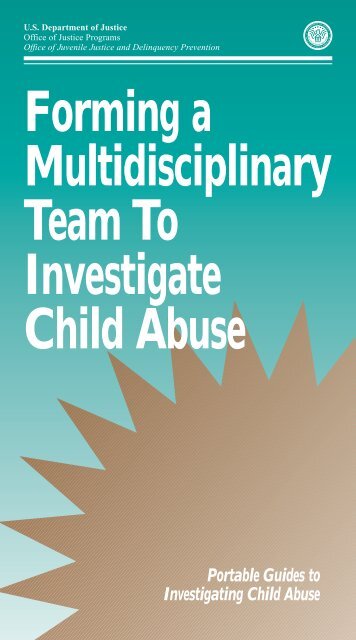
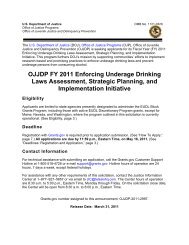

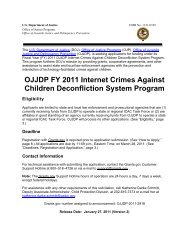
![Chapter 5 [PDF] - Office of Juvenile Justice and Delinquency ...](https://img.yumpu.com/46584340/1/190x245/chapter-5-pdf-office-of-juvenile-justice-and-delinquency-.jpg?quality=85)

